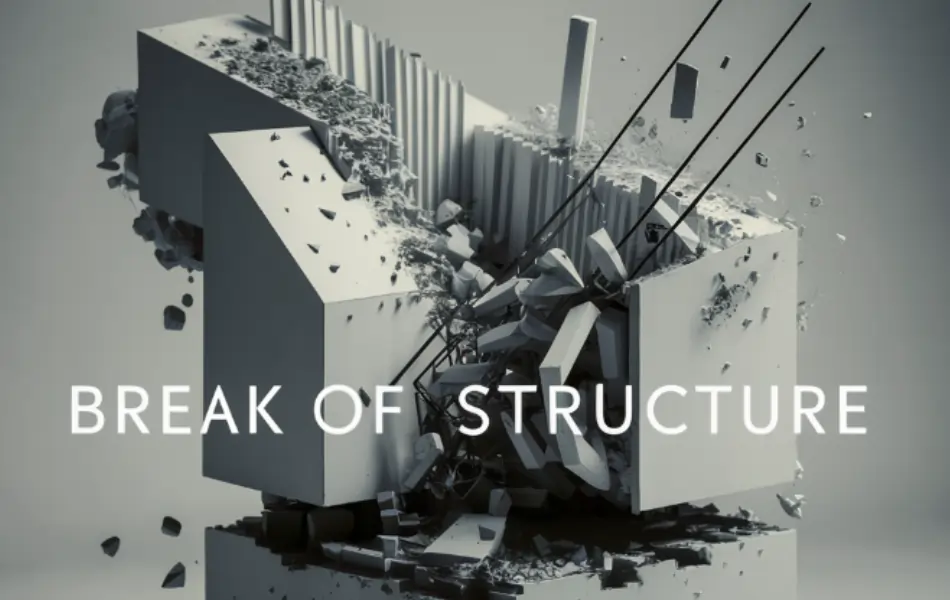
If you’re a novice trader wondering what the hell is Break of Structure all about?
Please calm down… it’s not that deep… 🤪
The name says it all! It is the breaking of a structure! Which structure? Market structure, dummy! 😤
Don’t worry, in the upcoming sections, I’ve covered the details of market structure as well!
Okay…so let’s jump right in!
📐 Starting Off with Market Structure 📐
Before diving into the details of the Break of Structure… let's first grasp the concept of market structure (as promised 😉)
Market structure is just the trend or pattern that an asset's price follows over a given period!
Technical analysts often categorize market structures into three main types: bullish, bearish, and ranging.
1. Bullish Market: 🐮

What does the word “bullish” tell you? Strong? Powerful? Top tier? That’s exactly what a bullish market is!
But… that’s not where it gets its name from! It is how the animal attacks…upward (with its horns)! ⬆🐮
A bull market is a period of optimism and rising stock prices! Investors are confident that the economy is growing, and companies are performing well.
During a bull market, stock prices trend upwards, often setting new highs. Investor sentiment is positive, and there is a general belief that the good times will continue.
However, no bull market lasts forever, and periods of decline (bear markets) are an inevitable part of the economic cycle.
2. Bearish Market: 🐻

Now, you might be wondering…If a bullish market is higher highs and higher lows, which means bearish should be lower lows and lower highs?
Well… You’re absolutely right! But what’s with the name then?
Again, it is how the animal attacks! A bear swipes down! ⬇🐻
A bear market is a period of declining stock prices and negative investor sentiment.
Bear markets, however, are a normal part of the market cycle and have historically been followed by bull markets, where stock prices rise again.
But the bear market has its pros as well! It can present opportunities for long-term investors to buy stocks at lower valuations!
3. Ranging Structure: 📊

The ranging market is when Mr Market is deciding whether to transform into a bull or a bear🐮🐻🙄
Here, you’ll have to trade within a defined range without showing a clear upward or downward trend.
This type of market often occurs after a significant price move, as buyers and sellers reach equilibrium, leading to a period of consolidation.
Ranging markets can be challenging to understand, as the lack of a clear trend can lead to whipsaws and false breakouts!
Uncovering the Break of Structure | What is it all about?
Now… let’s come to the Break of Structure! First of all, it falls into the arena of technical analysts! 🤝
The Break of Structure is change… in an upward or downward trend…
This change can be abrupt or gradual… depending on Mr Market’s mood (I mean not really… there may be several other factors, but you get the point!)
This change can manifest in various ways, depending on the type of market structure in play!
In a bullish market structure, a Break of Structure would be characterized by a significant price drop below a previously established support level, indicating that sellers have gained the upper hand and the upward trend may be reversing.
Conversely, in a bearish market structure, a Break of Structure would occur when the asset's price surges above a key resistance level, suggesting that buyers are regaining control and the downward trend may be coming to an end.
In a ranging market structure, a Break of Structure would involve the asset's price breaking out of the established horizontal range, either to the upside or downside, signaling the potential emergence of a new trend.
How to Trade a Break of Structure (BOS)?
Let me give you a brief and quick little something on how to trade a break of structure!
Here's how you can approach trading during a BOS:
- Identify key support and resistance levels: First identify key support and resistance levels on your chart using technical analysis tools like trendlines, pivot points, or previous swing highs/lows.
- Look for a clear break: A BOS is characterized by a strong, impulsive move that breaks through the identified support or resistance level. Ensure that the break is accompanied by increased volume and momentum, as this increases the likelihood of a genuine trend change.
- Wait for a retest: Once you spot the price breaking through one of these levels with conviction, wait for a pullback to retest the broken level. This allows you to get a better entry price and confirms the breakout is legitimate.
- Set your entry and exit: Place your stop loss just below the retest level for a buy trade, or above for a sell trade. Your target can be the next logical support/resistance level or a fixed risk: reward ratio like 1:2 or 1:3. Manage your risk properly and only take trades that provide a good potential reward relative to the risk taken.
- Manage your trade: Monitor the trade and consider adjusting your stop-loss or taking partial profits as the trade progresses. A BOS can sometimes lead to a prolonged trend, so be prepared to trail your stop-loss or scale out of the position gradually.
✔ FAQs on a Break of Structure ✔
What is the difference between a BOS and a Change of Character (ChoCh)?
A BOS signifies trend continuation by producing new highs or lows, while a Change of Character (ChoCh) occurs when the market breaks a significant swing point in the opposite direction of the current trend, potentially indicating the start of a new trend or reversal.
What is the difference between a BOS and a Market Structure Shift (MSS)?
A BOS indicates potential trend continuation, while a Market Structure Shift (MSS) not only suggests a potential trend reversal but also establishes the beginnings of a new trend by setting a lower high or higher low before breaking through the existing trend's strong swing point.
What is the “Break of Structure entry”?
The Break of Structure entry is the trade entry based on a Break of Structure trading strategy, formed using chart patterns, structures like supply and demand zones, or indicators that help identify market structure breaks.
What tools can help identify a BOS?
Common tools used to identify a BOS include support and resistance levels, trend lines, channels, and technical indicators like moving averages and oscillators.
Is a BOS a guarantee of a sustained trend?
No, a BOS is not a guarantee of a sustained trend. It is a signal that requires careful analysis and risk management.
What is the importance of the “retest” in a BOS strategy?
The retest serves as a confirmation of the new trend and can provide a favorable entry point for traders to initiate positions.
Final Thoughts 🤝

I hope you now understand the break of structure inside out! 🤝
Having said that, you still need experience to really hone the skill of BOS!
It’ll take some time and practice 💪
But DO NOT SIT BACK! Keep Trading and one day you’ll master it! All the best!


![Equity in Forex Trading 📖 Forex Glossary [2024’s Edition] 7 Equity in Forex Trading 📖 Forex Glossary [2024’s Edition]](https://fxparkey.com/wp-content/uploads/2024/04/Equity-300x189.webp)
![Commodities in Trading 📖 Forex Glossary [2024’s Edition] 8 Commodities in Trading 📖 Forex Glossary [2024’s Edition]](https://fxparkey.com/wp-content/uploads/2024/01/Commodities-1-300x150.webp)
![Derivatives in Forex Trading 📖 Forex Glossary [2024’s Edition] 9 Derivatives in Forex Trading 📖 Forex Glossary [2024’s Edition]](https://fxparkey.com/wp-content/uploads/2024/04/Derivatives-2-300x189.webp)
![Currency Pairs in Trading 📖 Forex Glossary [2024’s Edition] 10 Currency Pairs in Trading 📖 Forex Glossary [2024’s Edition]](https://fxparkey.com/wp-content/uploads/2024/01/Currency-Pairs-300x150.webp)
